engine overheat SATURN SKY 2007 Owners Manual
[x] Cancel search | Manufacturer: SATURN, Model Year: 2007, Model line: SKY, Model: SATURN SKY 2007Pages: 384, PDF Size: 2.47 MB
Page 81 of 384

To prevent gear damage, this system also
prevents cranking if the engine is already
running. Engine cranking can be stopped by
turning the ignition switch to ACC or LOCK.
Notice:Cranking the engine for long periods
of time, by returning the key to the START
position immediately after cranking has ended,
can overheat and damage the cranking
motor, and drain the battery. Wait at least
15 seconds between each try, to allow
the cranking motor to cool down.
2. If the engine does not start after 5-10 seconds,
especially in very cold weather (below 0°F
or−18°C), it could be �ooded with too much
gasoline. Try pushing the accelerator
pedal all the way to the �oor and holding it
there as you hold the key in START for up to
a maximum of 15 seconds. Wait at least
15 seconds between each try, to allow the
cranking motor to cool down. When the engine
starts, let go of the key and accelerator.If the vehicle starts brie�y but then stops
again, do the same thing. This clears the extra
gasoline from the engine. Do not race the
engine immediately after starting it. Operate
the engine and transmission gently until the oil
warms up and lubricates all moving parts.
Notice:Your engine is designed to work with
the electronics in your vehicle. If you add
electrical parts or accessories, you could
change the way the engine operates. Before
adding electrical equipment, check with
your retailer. If you do not, your engine might
not perform properly. Any resulting damage
would not be covered by your vehicle’s
warranty.
81
ProCarManuals.com
Page 87 of 384
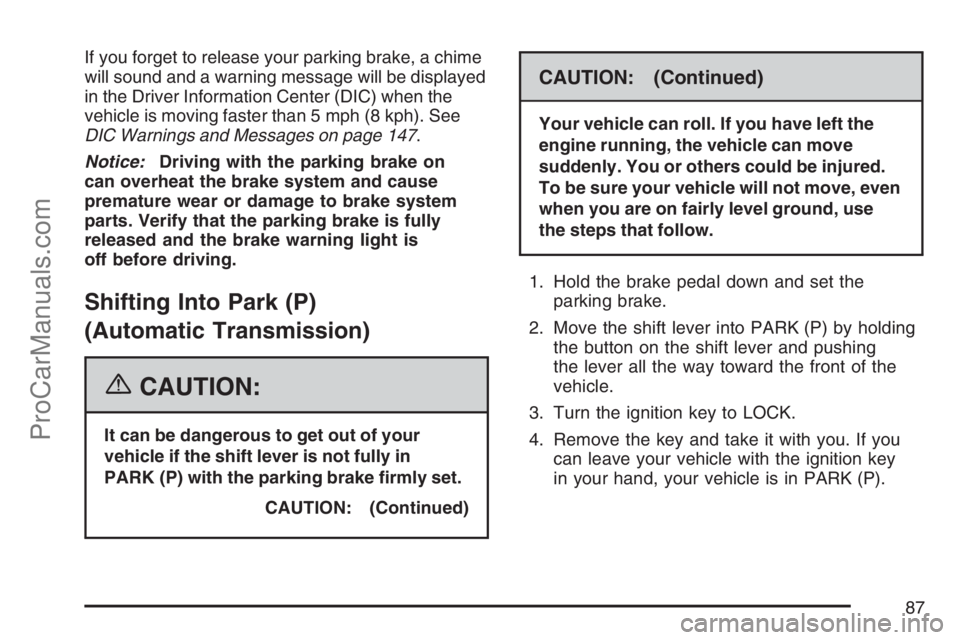
If you forget to release your parking brake, a chime
will sound and a warning message will be displayed
in the Driver Information Center (DIC) when the
vehicle is moving faster than 5 mph (8 kph). See
DIC Warnings and Messages on page 147.
Notice:Driving with the parking brake on
can overheat the brake system and cause
premature wear or damage to brake system
parts. Verify that the parking brake is fully
released and the brake warning light is
off before driving.
Shifting Into Park (P)
(Automatic Transmission)
{CAUTION:
It can be dangerous to get out of your
vehicle if the shift lever is not fully in
PARK (P) with the parking brake �rmly set.
CAUTION: (Continued)
CAUTION: (Continued)
Your vehicle can roll. If you have left the
engine running, the vehicle can move
suddenly. You or others could be injured.
To be sure your vehicle will not move, even
when you are on fairly level ground, use
the steps that follow.
1. Hold the brake pedal down and set the
parking brake.
2. Move the shift lever into PARK (P) by holding
the button on the shift lever and pushing
the lever all the way toward the front of the
vehicle.
3. Turn the ignition key to LOCK.
4. Remove the key and take it with you. If you
can leave your vehicle with the ignition key
in your hand, your vehicle is in PARK (P).
87
ProCarManuals.com
Page 88 of 384

Leaving Your Vehicle With the
Engine Running
{CAUTION:
It can be dangerous to leave your vehicle
with the engine running. Your vehicle
could move suddenly if the shift lever is
not fully in PARK (P) with the parking
brake �rmly set. And, if you leave the
vehicle with the engine running, it could
overheat and even catch �re. You or
others could be injured. Do not leave your
vehicle with the engine running.
If you have to leave your vehicle with the engine
running, be sure your vehicle is in PARK (P)
and your parking brake is �rmly set before you
leave it. After you have moved the shift lever into
PARK (P), hold the regular brake pedal down.If the vehicle has an automatic transmission, see if
you can move the shift lever away from PARK (P)
without �rst pushing the shift lock release button.
If you can, it means that the shift lever was not fully
locked into PARK (P).Torque Lock
If you are parking on a hill and you do not
shift your transmission into PARK (P) properly,
the weight of the vehicle may put too much
force on the parking pawl in the transmission.
You may �nd it difficult to pull the shift lever
out of PARK (P). This is called “torque lock.”
To prevent torque lock, set the parking brake
and then shift into PARK (P) properly before you
leave the driver’s seat. To �nd out how, see
Shifting Into Park (P) (Automatic Transmission)
on page 87.
88
ProCarManuals.com
Page 137 of 384

If the light is on and �ashing, the TCS or the
ESC system is actively working. Check the
DIC messaging for details to determine which
system is working. If the LOW TRACTION
message appears, the system is limiting wheel
spin. If the ESC ACTIVE message appears,
the system is aiding in maintaining vehicle
directional control.
SeeElectronic Stability Control on page 201and
Traction Control System (TCS) on page 199
for more information.
SeeDIC Warnings and Messages on page 147
for more information on the messages associated
with this light.Engine Coolant Temperature
Warning Light
The engine coolant
temperature warning
light will come on
when the engine has
overheated.
If this happens you should pull over and turn off
the engine as soon as possible. SeeEngine
Overheating on page 258for more information.
Notice:Driving with the engine coolant
temperature warning light on could cause your
vehicle to overheat. SeeEngine Overheating
on page 258. Your vehicle could be damaged,
and it might not be covered by your warranty.
Never drive with the engine coolant
temperature warning light on.
This light will also come on brie�y when starting
your vehicle. If it does not, have your vehicle
serviced.
137
ProCarManuals.com
Page 224 of 384
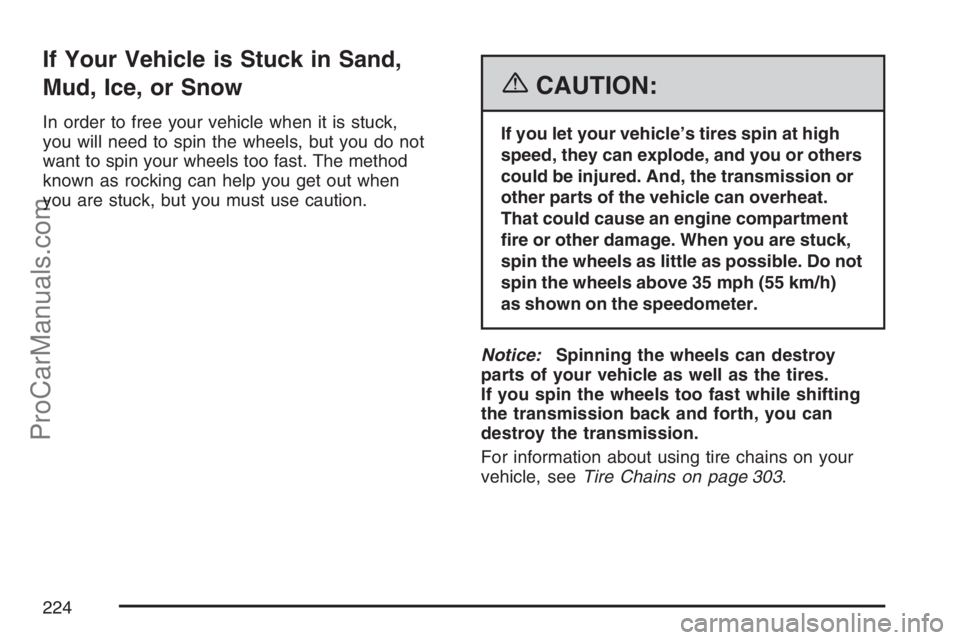
If Your Vehicle is Stuck in Sand,
Mud, Ice, or Snow
In order to free your vehicle when it is stuck,
you will need to spin the wheels, but you do not
want to spin your wheels too fast. The method
known as rocking can help you get out when
you are stuck, but you must use caution.
{CAUTION:
If you let your vehicle’s tires spin at high
speed, they can explode, and you or others
could be injured. And, the transmission or
other parts of the vehicle can overheat.
That could cause an engine compartment
�re or other damage. When you are stuck,
spin the wheels as little as possible. Do not
spin the wheels above 35 mph (55 km/h)
as shown on the speedometer.
Notice:Spinning the wheels can destroy
parts of your vehicle as well as the tires.
If you spin the wheels too fast while shifting
the transmission back and forth, you can
destroy the transmission.
For information about using tire chains on your
vehicle, seeTire Chains on page 303.
224
ProCarManuals.com
Page 231 of 384

Service........................................................ 233
Accessories and Modi�cations................... 233
California Proposition 65 Warning.............. 234
Doing Your Own Service Work.................. 234
Adding Equipment to the Outside
of Your Vehicle...................................... 235
Fuel............................................................. 235
Gasoline Octane........................................ 235
Gasoline Speci�cations.............................. 236
California Fuel........................................... 236
Additives................................................... 236
Fuels in Foreign Countries........................ 237
Filling the Tank......................................... 238
Filling a Portable Fuel Container............... 240
Checking Things Under the Hood.............. 240
Hood Release........................................... 241
Engine Compartment Overview.................. 242
Engine Oil................................................. 245
Engine Oil Life System.............................. 250
Engine Air Cleaner/Filter............................ 252
Automatic Transmission Fluid.................... 254
Manual Transmission Fluid........................ 254
Hydraulic Clutch........................................ 254Engine Coolant.......................................... 255
Coolant Surge Tank Pressure Cap............ 258
Engine Overheating................................... 258
Cooling System......................................... 260
Power Steering Fluid ................................. 266
Windshield Washer Fluid........................... 267
Brakes...................................................... 268
Battery...................................................... 271
Jump Starting............................................ 272
Rear Axle.................................................... 278
Headlamp Aiming........................................ 278
Bulb Replacement....................................... 279
Halogen Bulbs........................................... 279
Headlamps and Parking Lamps................. 279
Front Turn Signal, Parking and
Fog Lamps............................................ 280
Taillamps, Turn Signal, Stoplamps
and Sidemarker Lamps.......................... 281
Back-Up Lamps......................................... 282
License Plate Lamp................................... 282
Replacement Bulbs................................... 283
Windshield Wiper Blade Replacement....... 283
Section 5 Service and Appearance Care
231
ProCarManuals.com
Page 255 of 384
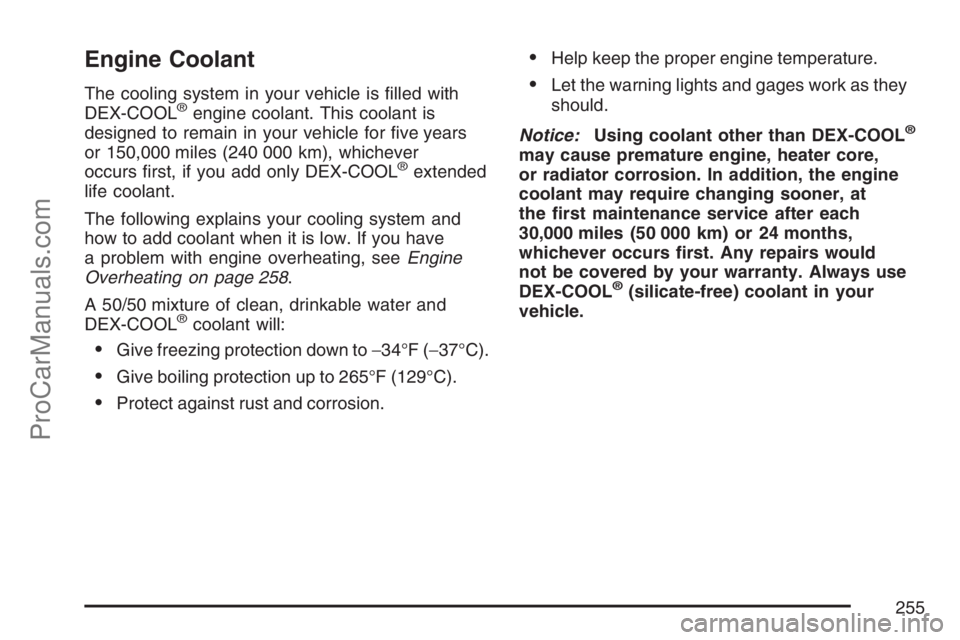
Engine Coolant
The cooling system in your vehicle is �lled with
DEX-COOL®engine coolant. This coolant is
designed to remain in your vehicle for �ve years
or 150,000 miles (240 000 km), whichever
occurs �rst, if you add only DEX-COOL
®extended
life coolant.
The following explains your cooling system and
how to add coolant when it is low. If you have
a problem with engine overheating, seeEngine
Overheating on page 258.
A 50/50 mixture of clean, drinkable water and
DEX-COOL
®coolant will:
Give freezing protection down to−34°F (−37°C).
Give boiling protection up to 265°F (129°C).
Protect against rust and corrosion.
Help keep the proper engine temperature.
Let the warning lights and gages work as they
should.
Notice:Using coolant other than DEX-COOL
®
may cause premature engine, heater core,
or radiator corrosion. In addition, the engine
coolant may require changing sooner, at
the �rst maintenance service after each
30,000 miles (50 000 km) or 24 months,
whichever occurs �rst. Any repairs would
not be covered by your warranty. Always use
DEX-COOL
®(silicate-free) coolant in your
vehicle.
255
ProCarManuals.com
Page 256 of 384
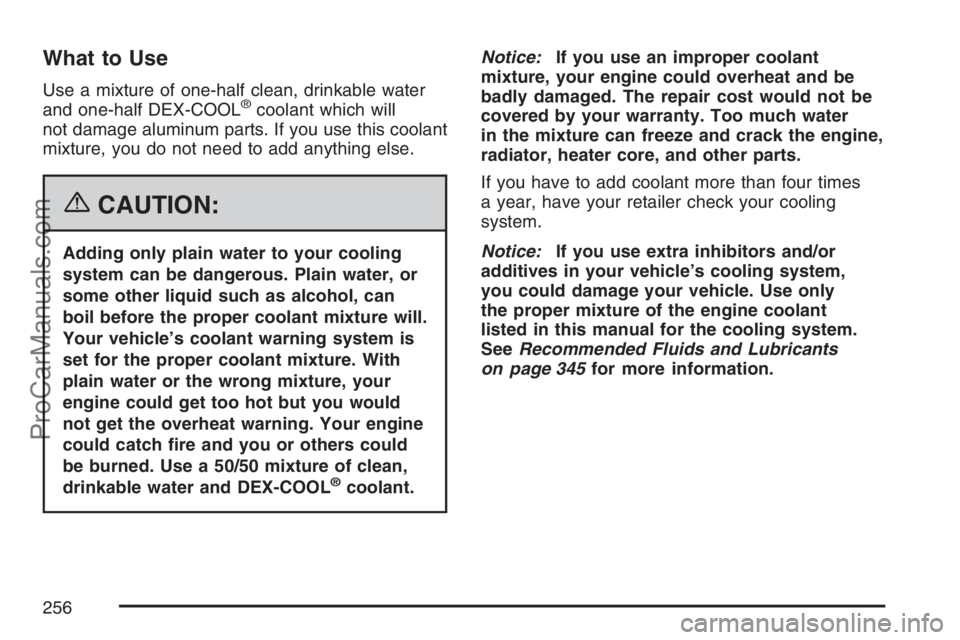
What to Use
Use a mixture of one-half clean, drinkable water
and one-half DEX-COOL®coolant which will
not damage aluminum parts. If you use this coolant
mixture, you do not need to add anything else.
{CAUTION:
Adding only plain water to your cooling
system can be dangerous. Plain water, or
some other liquid such as alcohol, can
boil before the proper coolant mixture will.
Your vehicle’s coolant warning system is
set for the proper coolant mixture. With
plain water or the wrong mixture, your
engine could get too hot but you would
not get the overheat warning. Your engine
could catch �re and you or others could
be burned. Use a 50/50 mixture of clean,
drinkable water and DEX-COOL
®coolant.Notice:If you use an improper coolant
mixture, your engine could overheat and be
badly damaged. The repair cost would not be
covered by your warranty. Too much water
in the mixture can freeze and crack the engine,
radiator, heater core, and other parts.
If you have to add coolant more than four times
a year, have your retailer check your cooling
system.
Notice:If you use extra inhibitors and/or
additives in your vehicle’s cooling system,
you could damage your vehicle. Use only
the proper mixture of the engine coolant
listed in this manual for the cooling system.
SeeRecommended Fluids and Lubricants
on page 345for more information.
256
ProCarManuals.com
Page 258 of 384

Adding Coolant
If you need more coolant, add the proper
DEX-COOL®coolant mixture at the coolant surge
tank, but only when the engine is cool. If the
coolant surge tank is empty, a special �ll
procedure is necessary. SeeEngine Overheating
on page 258for instructions on “How to Add
Coolant to the Coolant Surge Tank.”
{CAUTION:
You can be burned if you spill coolant
on hot engine parts. Coolant contains
ethylene glycol, and it will burn if the
engine parts are hot enough. Do not spill
coolant on a hot engine.
When replacing the pressure cap, make sure it
is hand-tight and fully seated.
Coolant Surge Tank Pressure Cap
Notice:If the pressure cap is not tightly
installed, coolant loss and possible engine
damage may occur. Be sure the cap is properly
and tightly secured.
The coolant surge tank pressure cap must be fully
installed on the coolant surge tank. SeeEngine
Compartment Overview on page 242for more
information on location.
Engine Overheating
There is an engine coolant temperature warning
light on your vehicle’s instrument panel. See
Engine Coolant Temperature Warning Light
on page 137for more information.
258
ProCarManuals.com
Page 259 of 384
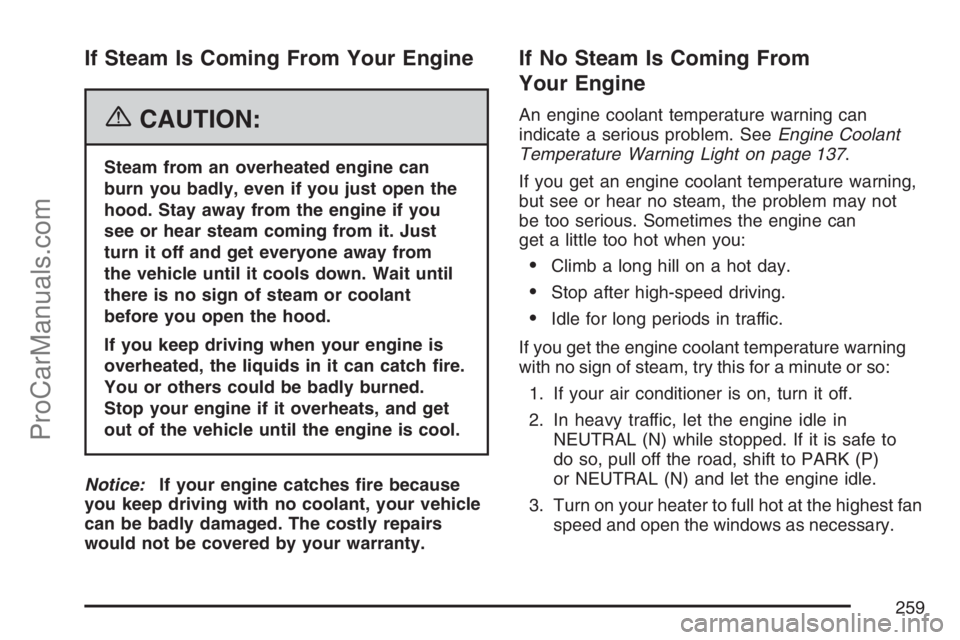
If Steam Is Coming From Your Engine
{CAUTION:
Steam from an overheated engine can
burn you badly, even if you just open the
hood. Stay away from the engine if you
see or hear steam coming from it. Just
turn it off and get everyone away from
the vehicle until it cools down. Wait until
there is no sign of steam or coolant
before you open the hood.
If you keep driving when your engine is
overheated, the liquids in it can catch �re.
You or others could be badly burned.
Stop your engine if it overheats, and get
out of the vehicle until the engine is cool.
Notice:If your engine catches �re because
you keep driving with no coolant, your vehicle
can be badly damaged. The costly repairs
would not be covered by your warranty.
If No Steam Is Coming From
Your Engine
An engine coolant temperature warning can
indicate a serious problem. SeeEngine Coolant
Temperature Warning Light on page 137.
If you get an engine coolant temperature warning,
but see or hear no steam, the problem may not
be too serious. Sometimes the engine can
get a little too hot when you:
Climb a long hill on a hot day.
Stop after high-speed driving.
Idle for long periods in traffic.
If you get the engine coolant temperature warning
with no sign of steam, try this for a minute or so:
1. If your air conditioner is on, turn it off.
2. In heavy traffic, let the engine idle in
NEUTRAL (N) while stopped. If it is safe to
do so, pull off the road, shift to PARK (P)
or NEUTRAL (N) and let the engine idle.
3. Turn on your heater to full hot at the highest fan
speed and open the windows as necessary.
259
ProCarManuals.com